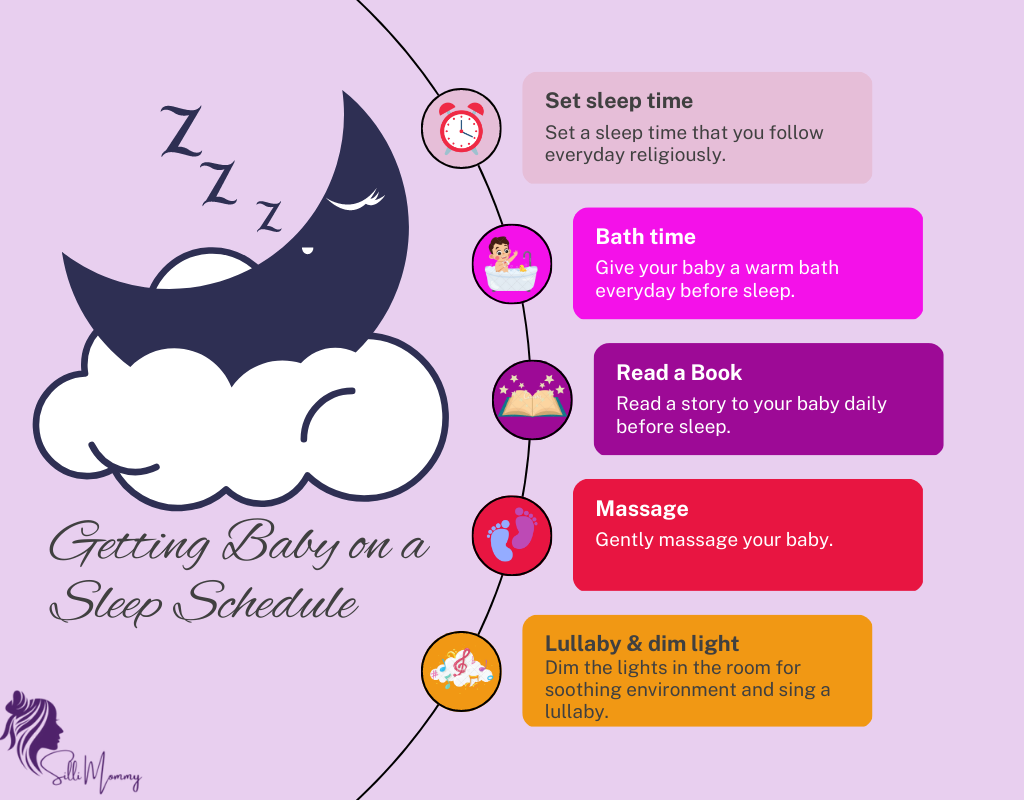Are you finding effective sleep training methods for your baby? Getting baby on sleep schedule is sometimes the most daunting task for new parents. However, establishing healthy sleep habits would be challenging not only for your baby’s development but also for your sanity. Fortunately, there are tried and effective sleep training methods to try. In this article, we’ll explore the top 5 most effective baby sleep training methods you need to try.
Table of Contents
Introduction
Parents can try several effective infant sleep training techniques to help their newborns develop healthy sleep habits. These techniques vary in approach and can be tailored to suit the individual needs of your baby and family. It’s important to note that creating a conducive newborn sleep environment is also an essential part of sleep training. This includes providing a comfortable and safe sleeping space, minimizing noise and light, and maintaining an appropriate temperature. By combining effective sleep training methods with a positive sleep environment, you can help your newborn develop healthy sleep habits that will benefit them for years to come.
Why sleep training is important?

Sleep training is important because it helps establish a regular sleep schedule for your baby. This can help improve their sleep quality and ensure they are getting enough rest. A well-rested baby is more likely to be happy and alert during the day, which can positively impact their overall development.
Baby Sleep Patterns
Before delving into specific baby sleep training techniques, you must know the different stages of baby sleep. Newborns are most likely to sleep in REM (Rapid Eye Movement). This is when dreams occur, and it’s essential for brain development. Non-REM (Rapid Eye Movement) rest, on the other hand, is divided into three stages, with the most profound stage being the most refreshing. Understanding the different stages of sleep can help you identify your baby’s sleep cues and establish a consistent bedtime routine that works for them. Babies’ sleep duration in the first few months will vary as they grow. Newborns need up to 18 hours of sleep daily, 6-month-olds need around 14 hours, and toddlers need approximately 12 hours.
Sleep Training Techniques
Finding the best sleep training technique for your baby is another challenging task for a new parent. Here are some of the most effective baby sleep training methods you can try.

Cry-it-out method/Freber Method
The Ferber method, or “cry it out” method, allows you to let your baby cry for a limited time before you go and cuddle them. The time you wait before settling them gradually increases until your baby learns to fall asleep independently. This method has been proven effective for many parents, but it may only work for some. But consider your baby’s temperament before trying this method.
Graduated extinction
Graduated extinction is a method that is similar to the Cry-it-out method, but it involves gradually increasing the amount of time you let your baby cry before going in to check on them. For example, you may let your baby cry for 5 minutes, then go in to check on them, then let them cry for 10 minutes, and so on. This method can be effective for some families but may not work for others. Additionally, this method may not be effective for babies with a strong sleep association and certain sleep aids.
Gentle sleep training
Gentle sleep training is another method that can be effective for some families. This method involves gradually teaching your baby to fall asleep independently by reducing your assistance during bedtime. For example, you may start by rocking your baby to sleep and slowly decrease the time you rock them each night until they can fall asleep independently. This method can take longer than other infant sleep training techniques but can be less stressful for you and your baby. It’s important to note that gentle sleep training may not be practical for babies with a strong sleep association and few sleep aids, such as pacifiers or being held.
Bedtime fading
Bedtime fading is a method that involves gradually pushing back your baby’s bedtime until they can fall asleep on their own. This method can be effective for babies with trouble falling asleep at bedtime. To implement bedtime fading, you would start by putting your baby to bed at their usual bedtime. If they don’t fall asleep within a set amount of time, you would gradually push back their bedtime by 15-30 minutes each night until they can fall asleep later.
Co-sleeping
Co-sleeping is a sleep training method that allows you to let your baby sleep with you. This can be in the same or a separate bed in the same room. The idea behind co-sleeping is to make your baby feel safe and secure, which can help them sleep better. Co-sleeping can be effective for some families, it’s necessary to follow safe sleep practices, but it might not work for others. Additionally, some parents find that co-sleeping can lead to interrupted sleep, as their baby may wake up more frequently throughout the night.
Nighttime Routine for Babies
You must set a persistent bedtime routine to help your baby feel secure and calm before bed. A typical bedtime routine might include a warm bath, a story, and a lullaby. You can also incorporate calming activities, such as massage or gentle rocking. Creating a relaxing sleep environment with a comfortable mattress, appropriate room temperature, and low lighting would be helpful for you.

Sleep Association Habits
Babies develop sleep associations, which are objects or actions that they associate with falling asleep. Common sleep associations include nursing, rocking, or sucking on a pacifier. While these can help get your baby to sleep, they can also become problematic if your baby relies on them to fall asleep and can’t self-soothe when they wake up at night. Breaking negative sleep associations can be difficult, but necessary to establish healthy ones. Positive sleep associations include a comfy or consistent bedtime routine.
Best Sleep Training Techniques
Some tips can make the process smoother regardless of your sleep training method. These include:
- Identifying your baby’s sleep cues, such as rubbing their eyes or yawning.
- Knowing when to adjust your sleep training method if it’s not working for your baby.
- Staying consistent with your approach, even if it’s challenging.
Conclusion
Choosing the most effective sleep training method can be exhausting, but it’s important to remember that every baby is different. What works for your baby might not be ideal for another baby. You are required to be patient, consistent, and flexible when establishing a sleep routine for your baby. The methods mentioned above have proven effective for many parents, but what works best for you depends on your baby. With some trial and error, you’ll know which technique works for your family and get the sleep you need.
FAQs
When should I start sleep training my baby?
Sleep training is a personal decision that depends on your baby’s age, sleep patterns, and your family’s needs. However, most experts recommend waiting until your baby is at least four to six months old before starting sleep training.
Is sleep training safe for my baby?
Yes, sleep training can be safe for your baby when done correctly and with proper guidance. However, it’s important to follow safe sleep practices and consult with your pediatrician before getting baby on sleep schedule.
How long does it take to see results from sleep training?
Some babies may respond quickly to sleep training and start sleeping longer stretches at night within a few days, whereas, others may take longer to adjust. It’s important to be patient and consistent with your best sleep training techniques, as consistency is key to success.
Can I use multiple sleep training methods at once?
It’s best to getting baby on sleep schedule with a method that feels comfortable for you and your baby and stick with it consistently. This allows your baby to develop a consistent sleep routine and understand what’s expected of them during sleep time.
How do I know which sleep training method is right for my baby?
Choosing the effective sleep training method for your baby can depend on a variety of factors, including your baby’s age, temperament, sleep habits, and your family’s needs and preferences.
You should also consider your own parenting style and your baby’s temperament. Some babies may respond better to a more gradual sleep training approach, while others may need more direct intervention. You have to decide which is effective sleep training method for you.
What if my baby doesn’t respond to any of these methods?
If your baby doesn’t respond to any sleep training methods, it’s important to consult with your pediatrician or a pediatric sleep specialist to assess any underlying sleep issues or medical concerns.



I tried your tips and tricks and that works 🙂 thank you so much.